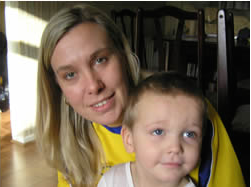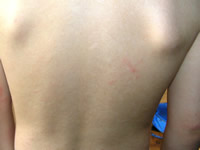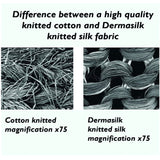Specification
DermaSilk Therapeutic Pyjamas - Sam's Story

Meet Sam.
He was one of the first people in the UK to try DermaSilk Therapeutic Clothing. Sam was 3 years of age and had been suffering from eczema all over his body since he was a month old. His regular medication included Protopic® Ointment, Dermovate® Cream, 50/50 white paraffin and liquid paraffin mix and cetirizine antihistamine.
For the case study he used DermaSilk pyjamas and gloves.

Sam's back before

Sam's Back After 14 days

Sam's Legs Before*

Sam's Legs After 14
Sam's mother Sandra:
"The improvement in Sam's skin over the past 14 days has been fantastic. Except for the time that Sam was in hospital having intensive treatment, I don't think I have seen his skin looking so good. Even my family have commented on how good he is looking. He is sleeping so much better at night which makes him happier during the day"
"Sam has not objected to wearing the pyjamas 24/7, and he even makes sure that I don't forget to put clean ones on when I change him. Although he has worn his gloves a few times it has been difficult keeping them on him. Because of this, and that he has not had any DermaSilk socks to wear, you can actually see the improvement the clothing has made compared to his hands and feet".
Update:
Sam is now 7 years old and a well behaved little boy at school. Since being introduced to DermaSilk he has never been wet wrapped once.
His emollient use is now 40% less than before and his flares are milder and less frequent.
He's on his third set of DermaSilk garments, which he wears to school without complaint.
DermaSilk Clinical Trials
The therapeutic effects of DermaSilk have been extensively studied by clinicians throughout Europe and their findings published in "peer reviewed" academic medical journals. This means that the results demonstrated in the trials have been independently assessed as accurate by other doctors. The abstracts below give a brief description of the studies undertaken and the results obtained. No other product of this type has gone through such exhaustive tests to validate its effectiveness. DermaSilk continues to be researched in a wide range of medical conditions and future publications will be added when appropriate.
Antimicrobial Silk Clothing in the Treatment of Atopic Dermatitis Proves Comparable to Topical Corticosteroid Treatment
Senti G and colleagues, Zurich University Hospital.- Published in Dermatology. Sept 2006. Issue 213. pp 228 - 233
Objective
To compare the efficacy of DermaSilk with that of a topical corticosteroid in the treatment of atopic dermatitis
Method
Fifteen children with moderate atopic dermatitis were enrolled into the study. They each received specially designed garments with the left arms and legs made of DermaSilk and the corresponding right limbs and whole trunk made of cotton. This was done so that each patient could try each type of medication at the same time.
The cotton covered limbs were treated with a topical corticosteroid cream once a day for the first 7 days of the study as would normally happen when using this medicine.
Both the DermaSilk and cotton covered limbs were given identical topical non-medicated emollients to moisturise the skin. No other treatments were applied.
In this way the only differences between the treatments was the DermaSilk on one side and the cotton plus corticosteroid cream on the other side.
Results were measured by 4 means
- A measure of the severity of the eczema.
- Patient / parent assessment of itch.
- Patient / parent assessment of overall improvement.
- Physicians global assessment.
Results were taken at the beginning of the study and on days 7 and 21.
Results
No differences in the eczema severity scores were found between the left and right side of individual patients at any time in the study. Similarly there was no difference in the patient or parent assessment of the effectiveness of each type of medication.
The Doctors assessment also showed no significant difference in the treatment groups at both day 7 and day 21.
Both types of treatment were well accepted by the parents and only one patient was withdrawn from the study due to a widespread flare up of their condition
Conclusions
The authors confirm and extend the findings reported by Ricci and his colleagues in the British Journal of Dermatology (2004) by demonstrating that not only is DermaSilk superior to cotton clothing but it is even comparable in clinical effectiveness to treatment with a potent topical corticosteroid used as normally prescribed.
The final paragraph of the paper says:
"The efficacy was comparable to that obtained by treating the patient with a modern class III topical corticosteroid and, thus, as good as the current standard care in Atopic Dermatitis."








